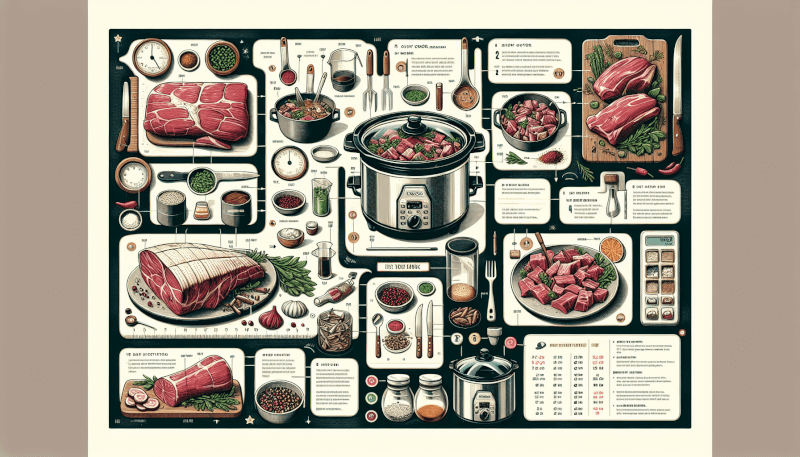If you’ve ever wondered about the secret to tender, flavorful meat that practically melts in your mouth, look no further than your trusty slow cooker. This article will guide you through the simple yet magical process of cooking meat in a slow cooker, where low and slow is the name of the game. From succulent pulled pork to fall-off-the-bone ribs, you’ll soon discover that the slow cooker is an essential tool for creating mouthwatering meals that effortlessly impress. So, grab your apron and get ready to unlock the secrets of slow cooking meat to perfection.

Choosing the Right Cut of Meat
When it comes to cooking meat in a slow cooker, choosing the right cut is crucial. While you might be inclined to go for the most tender cuts, it’s actually better to opt for less tender cuts like chuck, brisket, or shanks. These cuts have more connective tissue, which will break down during the long, slow cooking process, resulting in tender and flavorful meat.
Consider Less Tender Cuts
Less tender cuts of meat are perfect for slow cooking because the low and slow method helps to tenderize them. Cuts like chuck, brisket, or shanks are well-marbled and have more connective tissue, which will turn into gelatin during the cooking process. This gelatin adds richness and depth of flavor to the dish.
Trim Excess Fat
Before placing the meat in the slow cooker, it’s a good idea to trim any excess fat. While some fat is essential for flavor and juiciness, too much fat can result in a greasy finished dish. Trim any large pieces of visible fat, but leave some for flavor and moisture.
Use Bone-in Meat for Extra Flavor
If possible, choose bone-in cuts of meat for your slow cooker recipes. The bones add extra flavor and richness to the dish, as well as help to keep the meat moist during the long cooking process. The marrow from the bones will also release into the liquid, enhancing the overall taste of the dish.
Preparing the Meat
Now that you have chosen the perfect cut of meat for your slow cooker recipe, it’s time to prepare it for cooking.
Season the Meat
Before searing or marinating, it’s important to season the meat with salt and pepper. This helps enhance the flavors of the meat while it cooks. You can also add spices or herbs according to your taste preferences or the specific recipe you are following.
Sear the Meat
While not always necessary, searing the meat before placing it in the slow cooker can add a rich caramelized flavor to the dish. Heat a skillet over medium-high heat and sear the meat on all sides until nicely browned. This step adds an extra layer of flavor to your slow-cooked meat.
Marinate the Meat (Optional)
If you want to infuse additional flavors into your meat, you can marinate it before cooking. This step is optional but can be a great way to add depth and complexity to your dish. Choose a marinade that complements the flavors of the meat and let it rest in the refrigerator for a few hours or overnight.

Adding Liquid
Liquid is an important component of slow cooker recipes as it helps to create a delicious sauce or gravy that coats the meat and vegetables.
Choose the Right Amount of Liquid
When adding liquid to your slow cooker, it’s important to use the right amount. Too much liquid can result in a watery dish, while too little can lead to dry meat. As a general rule, use about 1/2 to 1 cup of liquid per pound of meat. However, keep in mind that some vegetables release liquid during the cooking process, so adjust accordingly.
Select the Appropriate Liquid
The choice of liquid will depend on your recipe and personal preferences. Common options include broth, stock, wine, beer, or even tomato sauce. Each liquid adds its unique flavor profile to the dish, so choose one that complements the other ingredients and enhances the overall taste.
Add Flavor with Broth or Stock
For an extra boost of flavor, consider using broth or stock as your liquid base. These savory liquids can add depth and richness to your slow cooker dish. You can opt for beef, chicken, vegetable, or even mushroom broth, depending on the flavor profile you want to achieve.
Selecting Vegetables and Aromatics
Vegetables and aromatics play a vital role in adding texture, flavor, and aroma to your slow cooker meals. Here’s how to choose the right ones for your dish.
Choose Suitable Vegetables
When selecting vegetables for your slow cooker recipe, opt for varieties that can withstand long cooking times without turning mushy. Root vegetables like carrots, potatoes, and turnips are excellent choices as they hold their shape and develop a delicious tenderness when slow-cooked. Other vegetables like onions, bell peppers, and celery can also add flavor and texture.
Add Aromatics for Extra Flavor
Aromatics like garlic, onions, herbs, and spices are essential for building layers of flavor in your slow cooker dish. The aromatic flavors infuse throughout the cooking process, adding a delightful fragrance to the final result. Garlic and onions are particularly versatile and work well with a wide range of meats and vegetables.

Layering Ingredients
Layering the ingredients properly in your slow cooker can ensure even cooking and consistent flavors throughout the dish.
Place Vegetables on the Bottom
To ensure that the vegetables cook evenly and thoroughly, place them at the bottom of the slow cooker. This allows them to benefit from direct heat and ensures they absorb the flavors from the meat and liquid as they tenderize.
Position Meat on Top of Vegetables
Once the vegetables are in place, position the meat on top of them. This helps the meat cook evenly while allowing the juices to trickle down and infuse the vegetables with flavor. Placing the meat on top also prevents the vegetables from becoming overcooked or turning mushy.
Cooking Techniques
The slow cooker is all about low and slow cooking, allowing the flavors to meld together gradually. Here are some techniques to perfect your slow cooker meals.
Cook on Low Heat for Longer Time
For the best results, cook the meat on low heat for a longer duration. Cooking on low allows the connective tissues to break down slowly, resulting in tender, juicy meat. This method also ensures that the flavors have ample time to develop and intensify, resulting in a more flavorful dish.
Adjust Cooking Time Based on Meat Type and Quantity
The cooking time will vary depending on the type of meat and the quantity you are preparing. Generally, most cuts of meat will take around 6-8 hours on low heat. However, larger cuts or tougher meats may require additional time. It’s important to follow the recipe instructions or consult a trusted source to determine the ideal cooking time.
Avoid Opening the Lid Frequently
While it may be tempting to check on your slow cooker meal frequently, resist the urge to open the lid too often. Each time you open the lid, heat escapes, and it takes time to regain the desired temperature. This can result in uneven cooking and increase the overall cooking time. Trust the process and let the slow cooker work its magic without interruption.

Testing Doneness
Determining when your slow cooker meat is perfectly cooked can be done with a few simple methods.
Check Internal Temperature with Meat Thermometer
To ensure your meat is cooked to your desired level of doneness, use a meat thermometer to check the internal temperature. Different meats have different recommended temperature ranges, so consult a cooking guide or recipe for the specific cuts you are using.
Try the Fork Test
Another method to check for doneness is the fork test. Simply insert a fork into the meat and twist gently. If the meat is tender and easily falls apart, it’s a good indication that it’s done. If there is resistance or the meat feels tough, it needs more time to cook.
Resting and Serving
Resting the meat after it’s done cooking is essential for optimal flavor and juiciness. Here’s what you need to do before serving.
Let Meat Rest
After removing the meat from the slow cooker, let it rest on a cutting board for a few minutes. This allows the juices to redistribute throughout the meat, resulting in a more flavorful and moist final product. Resting also makes it easier to carve or shred the meat, depending on your recipe.
Skim Excess Fat
While slow cooking results in deliciously tender meat, it can sometimes leave behind excess fat. Before serving, skim off any visible fat from the liquid in the slow cooker. This will help maintain the richness of the sauce or gravy while reducing the greasiness.
Serve with Accompaniments
Once the meat has rested and any excess fat has been removed, it’s time to serve your slow cooker creation. Pair the meat with your preferred accompaniments like mashed potatoes, rice, pasta, or crusty bread. The flavorful sauce or gravy from the slow cooker can be spooned over the meat and side dishes for an extra burst of taste.
Making Sauces or Gravies
The delicious juices and liquids left in the slow cooker can be transformed into a tasty sauce or gravy to elevate your dish further.
Using Slow Cooker Juices
To make a simple sauce or gravy, start by straining the liquid from the slow cooker. This will remove any solids and impurities, leaving you with a flavorful base. You can then boil the liquid in a saucepan to reduce it and concentrate the flavors. You may need to add a thickening agent like cornstarch or flour to achieve the desired consistency.
Making a Roux
If you prefer a thicker and richer sauce, consider making a roux. In a separate saucepan, melt butter and whisk in an equal amount of flour to create a paste. Cook the roux over low heat and gradually add the strained liquid from the slow cooker, whisking constantly until the desired thickness is reached.
Flavoring and Thickening the Sauce
Once you have the base sauce or gravy, you can further enhance the flavors by adding herbs, spices, or additional seasonings. Taste and adjust the seasoning as needed. If the sauce needs further thickening, continue to simmer over low heat until it reaches the desired consistency.
Storing Leftovers
If you have any leftovers from your slow cooked meat, proper storage is crucial to maintain freshness and safety.
Cool and Store Properly
Allow the leftover meat and any accompanying sauce or gravy to cool completely before transferring them to airtight containers or resealable bags. Refrigerate the leftovers promptly, ideally within two hours of cooking, to prevent bacterial growth. Be sure to label the containers with the date to keep track of freshness.
Reheat Leftovers Safely
When reheating the leftovers, do so in a microwave, stovetop, or oven until they reach a safe internal temperature. Use caution and do not let the meat sit at room temperature for too long to avoid any potential foodborne illnesses. Enjoy your delicious slow cooked meat again and savor the flavors once more.
Cooking meat in a slow cooker is a convenient and foolproof way to achieve tender and flavorful results. By choosing the right cut, preparing the meat properly, selecting suitable vegetables and aromatics, and utilizing the correct cooking techniques, you can create mouthwatering dishes that will impress your family and friends. Don’t forget to test for doneness, let the meat rest, and serve it with delicious accompaniments. And if you have any leftovers, store them safely to enjoy another meal later. With these tips in mind, you’ll be well on your way to slow cooking success!


